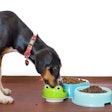
Pet food marketers and retailers in Canada, as is the case south of that border, do not have to hunt very far to find an audience for product innovation. Packaged Facts’ May 2020 survey of Canadian pet owners shows that 28% of dog owners and 23% of cat owners have changed the types of pet foods they use in the last 12 months, percentages nearly identical to that of their U.S. counterparts. Among the dog or cat owners who have recently changed pet foods, 16% have increased use of human/homemade foods, 13% have increased use of alternative pet food types such as dehydrated, freeze-dried, frozen, raw or refrigerated, and 12% have increased use of pet food toppings, mixers or add-ins.
Drivers to Canadian pet food choices, Canada vs. U.S.
As in the U.S. pet food market, nutrition and ingredients (including sourcing), pet pampering, and product safety and quality assurance are all significant drivers to pet food choices and changes among Canadian pet owners. Among these, optimizing pet food nutrition offers the most runway for product innovation. Among Canadian dog or cat owners:
- 76% somewhat or strongly agree that less processed pet foods are healthier.
- 74% somewhat or strongly agree that pet foods without artificial ingredients are healthier.
- 69% somewhat or strongly agree that it’s important to them personally to buy less processed pet foods.
With that said, Canadian dog or cat owners overall are slightly less likely than their U.S. counterparts to express strong agreement with psychographic statements pertaining to many of the current drivers of pet food innovation and premiumization. For example, 36% of pet food shoppers in the Canada vs. 42% in the U.S. strongly agree that “less processed pet foods are healthier for my pets,” while 25% vs. 29% strongly agree that they would buy natural/organic pet products were they more affordable, and 18% vs. 24% are strongly concerned about pet food contamination/product safety.
Drivers to Canadian pet food choices within Canada
However, the differences among dog or cat owners in Québec and those in Ontario or Western Canada prove much more significant that those between Canada and the U.S. overall (see Table 1). That is:
- 26% of pet food shoppers in Québec vs. 40% in Ontario or Western Canada strongly agree that “less processed pet foods are healthier for my pets.”
- 21% in Québec vs. 31% in Ontario strongly agree that they would buy natural/organic pet products were they more affordable.
- 13% in Québec vs. 21% in Western Canada are strongly concerned about pet food contamination and product safety.

TABLE 1: The various Canadian regions and provinces have differing thoughts when it comes to how they feed their pets. | (A7880S I Shutterstock.com)
At the same time, dog or cat owners in Québec are somewhat less likely to buy pet products online (41%) than is the case in Western Canada (45%) or especially Ontario (52%). The fact that pet owners in Ontario generally express the highest levels of concern about pet food issues points to a connection (with ambiguous chicken vs. egg causality) between shopping from the internet’s endless shelf of aggressively differentiated pet foods and heightened sensitivity to the potential shortcomings of more conventional pet food products, at least in relation to one’s own particular pet.
Even so, the more traditional “Old World” pet psychographics in francophone Québec may help themselves open up paths to pet food innovation. Within the Canadian pet market context, Québécois pet owners are more likely than average to include regular human foods in their pets’ diets, and conversely are less concerned about highly processed pet foods and less sold on pet food being made from human-grade ingredients.
With this more laissez-faire attitude toward pet foods, pet owners in Québec (home of sustainability oriented Wilder Harrier) are a bit more likely to be somewhat or strongly receptive (33%) to using insect protein in pet food or treats than are their Ontario (26%) or Western Canada (25%) compatriots — such that old-school pet food formats can continue finding ways to become new again.


















